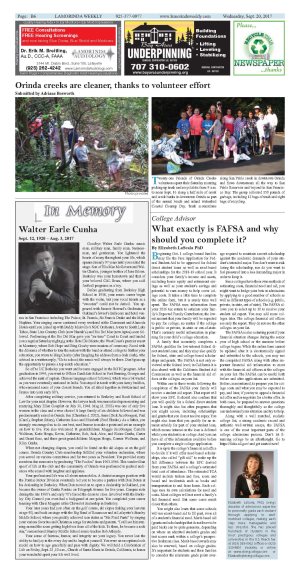| | Published September 20th, 2017
| College Advisor
| | What exactly is FAFSA and why should you complete it? | | By Elizabeth LaScala PhD |  | | Elizabeth LaScala, PhD, brings decades of admissions expertise to personally guide each student through applying to well-matched colleges, making each step more manageable and less stressful. She has placed hundreds of students in the most prestigious colleges and universities in the U.S. Reach her at (925) 385-0562 (office) or (925) 330-8801 (mobile), or online at www.doingcollege.com or Elizabeth@doingcollege.com. |
Beginning Oct. 1 college-bound families may file the Free Application for Federal Student Aid to be approved for federal direct student loans as well as need-based scholarships for the 2018-19 school year. It considers your family's income and assets, excluding home equity and retirement savings as well as your student's savings and potential to earn money to help cover college costs. It takes a little time to complete the online form, but it is surely time well spent. The FAFSA uses information from your 2016 tax return to estimate your family's Expected Family Contribution, the lowest amount that your family will be expected to pay for college, no matter if the college is public or private, in-state or out-of-state. That's certainly useful information in planning for your child's college education.
 A family that accurately completes a FAFSA qualifies for low-interest federal direct student loans; and they may also qualify for federal, state and college-based scholarships and grants. The FAFSA is not only reviewed at the federal level; in California it is also shared with the California Student Aid Commission as well as the financial aid offices at the colleges on your list.
A family that accurately completes a FAFSA qualifies for low-interest federal direct student loans; and they may also qualify for federal, state and college-based scholarships and grants. The FAFSA is not only reviewed at the federal level; in California it is also shared with the California Student Aid Commission as well as the financial aid offices at the colleges on your list.
 Within one to three weeks following the completion of the FAFSA your family will receive a student aid report. That report will show your EFC. It should also confirm that you will qualify for a federal direct student loan. It might also list other programs that you might access, including scholarships and grants that you do not need to repay. You might also learn that you qualify for an interest subsidy for part of your student loan, which means interest on the loan is deferred while your student is in college. And you can have all of this information available before you complete a single college application.
Within one to three weeks following the completion of the FAFSA your family will receive a student aid report. That report will show your EFC. It should also confirm that you will qualify for a federal direct student loan. It might also list other programs that you might access, including scholarships and grants that you do not need to repay. You might also learn that you qualify for an interest subsidy for part of your student loan, which means interest on the loan is deferred while your student is in college. And you can have all of this information available before you complete a single college application.
 It is up to the college's financial aid office to decide if it will offer need-based scholarships, also called "gift aid," to make up the full difference between the EFC derived from your FAFSA and a college's estimated total cost of attendance. The estimated TCA would include tuition and fees, room and board and incidentals such as books and transportation to and from home. Each college uses its own calculations for need and costs. Most colleges will not meet a family's full financial need. But some come much closer than others.
It is up to the college's financial aid office to decide if it will offer need-based scholarships, also called "gift aid," to make up the full difference between the EFC derived from your FAFSA and a college's estimated total cost of attendance. The estimated TCA would include tuition and fees, room and board and incidentals such as books and transportation to and from home. Each college uses its own calculations for need and costs. Most colleges will not meet a family's full financial need. But some come much closer than others.
 You might also learn that some schools will use merit-based aid to fill part, even all of a student's financial need. Merit-based aid (grants and scholarships that do not have to be paid back) can be quite generous, depending on where an admitted student's grades and test scores rank within a college's prospective freshman class. Merit-based awards may also be renewed, based on college grades. It's important for students and their families to consider the minimum grade point average required to maintain a merit scholarship against the academic demands of your student's intended major. You don't want to risk losing the scholarship, nor do you want to feel pressured into a less demanding major in order to keep it.
You might also learn that some schools will use merit-based aid to fill part, even all of a student's financial need. Merit-based aid (grants and scholarships that do not have to be paid back) can be quite generous, depending on where an admitted student's grades and test scores rank within a college's prospective freshman class. Merit-based awards may also be renewed, based on college grades. It's important for students and their families to consider the minimum grade point average required to maintain a merit scholarship against the academic demands of your student's intended major. You don't want to risk losing the scholarship, nor do you want to feel pressured into a less demanding major in order to keep it.
 Since colleges have their own methods of estimating costs, financial need and aid, you might want to hedge your bets in admissions by applying to a good number of schools as well as different types of schools (e.g. public, private, in state, out of state). The FAFSA allows you to select up to 10 to receive your student aid report. You may add more colleges later. The college financial aid offices see only the report. They do not see the other colleges on your list.
Since colleges have their own methods of estimating costs, financial need and aid, you might want to hedge your bets in admissions by applying to a good number of schools as well as different types of schools (e.g. public, private, in state, out of state). The FAFSA allows you to select up to 10 to receive your student aid report. You may add more colleges later. The college financial aid offices see only the report. They do not see the other colleges on your list.
 The FAFSA is also a starting point if your financial situation changes during the senior year of high school or the summer before college begins. While the online form cannot be updated after it is electronically signed and submitted to the schools, you may use the completed FAFSA along with other important financial aid information to meet with the financial aid officers at the colleges on your list. The FAFSA can be useful both before and after applications are submitted. Before, as mentioned, to prepare you for college costs and what you may be expected to pay, and later, if you try to appeal a financial aid offer and/or negotiate for a better offer. In both cases, be prepared to answer questions thoroughly and thoughtfully so the college can understand your situation and try to help.
The FAFSA is also a starting point if your financial situation changes during the senior year of high school or the summer before college begins. While the online form cannot be updated after it is electronically signed and submitted to the schools, you may use the completed FAFSA along with other important financial aid information to meet with the financial aid officers at the colleges on your list. The FAFSA can be useful both before and after applications are submitted. Before, as mentioned, to prepare you for college costs and what you may be expected to pay, and later, if you try to appeal a financial aid offer and/or negotiate for a better offer. In both cases, be prepared to answer questions thoroughly and thoughtfully so the college can understand your situation and try to help.
 Along with a well matched, realistic college list, a strong academic record and authentic well-written essays, the FAFSA is one of the most important parts of the college admissions process. Don't let financing college be an afterthought. Go to https://fafsa.ed.gov/ and get started now!
Along with a well matched, realistic college list, a strong academic record and authentic well-written essays, the FAFSA is one of the most important parts of the college admissions process. Don't let financing college be an afterthought. Go to https://fafsa.ed.gov/ and get started now!


|
| | | | | | | | | | | | |



